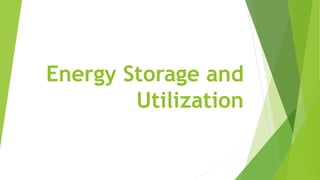
Energy storage and utilization
- 2. ATP (Adenosine Triphosphate) – the major source of energy in cell metabolism. - chemical energy converted from “electron energy” The Function of ATP transport work moving substances across cell membranes. used for mechanical work, supplying the energy needed for muscle contraction. supplies energy not only to heart muscle (for blood circulation) and skeletal muscle (such as for gross body movement), but also to the chromosomes and flagella to enable them to carry out their many functions. A major role of ATP is in chemical work, supplying the needed energy to synthesize the multi-thousands of types of macromolecules that the cell needs to exist. used as an on-off switch both to control chemical reactions and to send messages.
- 3. Plants use the energy in ATP molecules to move water, repair themselves, and grow. Plants vital energy conversions: 1. Light energy Electron energy 2. Electron energy Chemical energy (ATP 3. Chemical energy (ATP) sugars Respiration - the process in which nutrients are converted into useful energy in a cell
- 4. Photosynthesis - The entire process of trapping light energy into the bonds of a sugar molecule. Two processes involves: 1. Light-dependent Phase – solar energy is trapped and used to excite electrons to higher energy levels. These electrons are then passed down an electron transport chain, and the energy released is used to make ATP. After the electrons have completed their passage down the electron transport chain, they are passed to a second photosystem (known as photosystem I) and more light energy is harvested. Once the electrons have been given this energy, they are passed to molecule known as NADP (that then becomes NADPH) and held there ready to be used in the next phase of photosynthesis.
- 5. NAD - Nicotinamide adenine dinucleotide - is an important coenzyme found in cells. It plays key roles as a carrier of electrons and a participant in metabolic redox reactions, as well as in cell signaling. Nicotinamide adenine dinucleotide phosphate (NADP) - is the reduced form of NAD. The main role of NADP in metabolism is the transfer of electrons from one redox reaction to another, which is very important in the release of energy from nutrients.
- 6. Nicotinamide adenine dinucleotide phosphate-oxidase (NADPH) - is the reduced form of NADP. The NADPH oxidase complex is a cluster of proteins that donate an electron from NADPH to molecular oxygen (O2) to produce superoxide (O2-). This initiates the respiratory burst, a key step in immune defense against bacterial and fungal pathogens. The importance of this process to human health is manifested in chronic granulomatous disease (CGD), which refers to any of several hereditary diseases in which certain oxidase proteins are defective. An important role for NADPH oxidase in phagocytes is bacterial killing, which occurs in phagosomes.
- 7. Chloroplasts – an organelle that converts sunlight, carbon dioxide, and water into sugars in the process of photosynthesis. Photosystem II – embedded in the thylakoid membranes of chloroplasts, special solar collectors composed of pigment molecules, the major ones of which are chlorophyll a and chlorophyll b. Photolysis (“splitting by light”) – a process when the solar collector loses two of its electrons, they are replaced by electrons from an enzyme. The enzyme recovers its electrons by splitting a water molecule. Hydrogen ions are formed and oxygen gas is given off as a waste product. 2H2O 4H+ + 4e + O2 or Photosystem I – second solar collector
- 8. 2. The Light-independent Phase – short-term chemical and electron energy in the ATP and NADPH molecules are converted into long-term chemical energy in the covalent bonds of sugar molecules. The electrons are moved away from oxygen atoms and toward the carbon and hydrogen atoms. This is a nonspontaneous reaction requiring an input of energy that is then stored for later use by the cell. - Light-independent reactions of photosynthesis or dark reaction of photosynthesis Photosynthesis: CO2 + 2H2O CH2O + H2O + O2 -
- 9. Cellular Respiration - the most efficient way for cells to harvest energy stored in food. Respiration : C6H12O6 + O2 CO2 +H2O + Energy glucose oxygen carbon water dioxide
- 10. Aerobic Respiration - A vast majority of organisms break down sugar molecules all the way to carbon dioxide and water. Three major stages: 1. Glycolysis – glucose molecules (from starch or sucrose) are broken down into smaller 3-carbon units called pyruvate and some of the energy released is trapped as ATP and NADH. - Does not require oxygen 2. Krebs Cycle – the pieces of the glucose molecule left after glycolysis are broken all the way down to carbon dioxide. GTP (a nucleotide similar to ATP), NADH, and other high-energy molecules are formed. GTP - Guanosine triphosphate
- 11. 3. ATP Synthesis – NADH molecules formed in glycolysis and Krebs cycle are converted back to NAD molecules so that they be reused.
- 12. Anaerobic Respiration - Some organisms that do not require oxygen to regenerate. - Organisms depend on glycolysis to generate ATP and on fermentation to regenerate NAD. A byproduct of this reaction is ethanol. Fermentation is a metabolic process that converts sugar to acids, gases and/or alcohol. Pyruvate + NADH Ethanol + CO2 + NAD
- 13. Respiration and Photosynthesis Compared Photosynthesis 1. Occurs only in the chlorophyll- bearing cells of plants 2. Needs the presence of light 3. Water and carbon dioxide are used 4. oxygen is given off as a waste product 5. Food is built or synthesized 6. The weight of the plant is increased. 7. Energy is stored Respiration 1. Occurs in every living plant and animal cell 2. Occurs at all times 3. Water and carbon dioxide are given off as waste products 4. Oxygen is used in the process 5. Food is destroyed to release its energy. 6. The weight of the plant is decreased 7. Energy is released.
